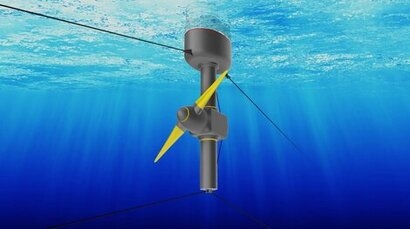
Aquantis’ Tidal Power Tug is a second generation floating tidal energy converter. The versatile spar-buoy platform supports a 10-metre diameter, two-bladed variable-pitch rotor and 160 kW drivetrain. By testing at EMEC’s scale test site, Aquantis will gain experience of marine operations, while generating performance data to validate its loading and dynamics model, controller functionality and load mitigation techniques.
EMEC will support Aquantis’ testing with tidal resource monitoring and the provision of its Test Support Buoy enabling remote communications with the device, data relay via EMEC’s supervisory control and data acquisition (SCADA) system and safe dissipation of power generated on site.
EMEC will also provide project management, operations, consenting, monitoring and performance testing support.
The demonstration of Aquantis’ Tidal Power Tug is supported by the Interreg North-West Europe’s Ocean DEMO project, led by EMEC. The tidal turbine is being developed via the US Department of Energy’s Advanced Research Projects Agency-Energy (ARPA-E) SHARKS (Submarine Hydrokinetic And Riverine Kilo-megawatt Systems) program.
“We are delighted to have this opportunity to test at EMEC’s world-class facility and work with the EMEC team” said Peter Stricker, Aquantis’ Chief Commercial Officer. “The Power Tug represents a number of design breakthroughs innovated through the SHARKS program, aimed at reducing the cost of energy. We will observe performance of this system for the first time operating in open water at the Shapinsay Sound test site. This promises to be a truly exciting moment for the Aquantis team as we prepare for deployment into the UK market.”
Richy Ainsworth, US Project Engineer, EMEC, added that while EMEC has long supported the development of marine energy in the United States, Aquantis will be the first US ocean energy developer to physically test at EMEC.
“The Shapinsay Sound test site provides a perfect testing ground for Aquantis” said Mr Ainsworth. “The scale test sites are designed to provide developers with their first real-sea experiences, in gentler conditions to our grid-connected sites, so that they can get to grips with installation processes, test survivability in the gritty, salty sea environment and collect data to verify models developed during tank testing. We’ll be working closely with Aquantis to help the team prepare for their demonstration and look forward to welcoming them to Orkney next year.”
For additional information:

